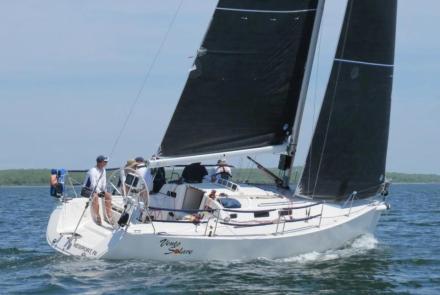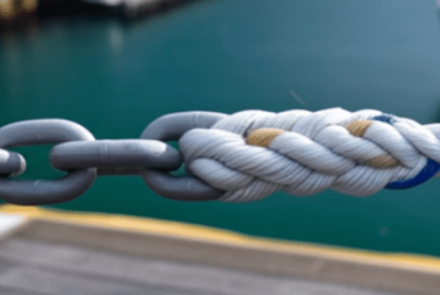Anchor Testing in the Chesapeake Bay
CCA Safety Moment
Chuck Hawley, May 6, 2015
In August of 2014, Fortress Anchors conducted an extensive anchor test on Chesapeake Bay, south of Solomon’s Island, in deep, sticky mud. I was asked to be the impartial observer, based on my participation in anchor tests for several decades.
One challenge is to make a test fair and, one would hope, repeatable. Cruisers expect our anchors to hold similarly in similar bottoms so that we can predict whether we’re going to have to stay up all night biting our nails, or nestled in our berths with no worries. Randomness makes virtually every night at anchor a nail-biter and greatly reduces our enjoyment when cruising.
For this test, a new method to reduce “randomness” was employed. The 82’ research vessel Rachel Carson was equipped with a dynamic positioning system that involved high accuracy GPS, twin swiveling jet drives, and a 50HP bow thruster. The intent was to hold Rachel Carson in exactly one spot, despite the effects of wind and current, and this in some cases, up to 3,000 pounds of tension on the anchor line. Thus, the vessel “anchored” itself to a latitude and longitude without actually anchoring, and then used a winch to pull the anchors towards the vessel while measuring their resistance. Anchor rode scope varied from about 8.3:1 to 5:1.
Authors as well known as Nigel Calder have criticized this methodology since it doesn’t entirely relate to how we anchor our own vessels. Boats don’t pull anchors through the mud with winches; boats pull on anchors using their rodes due to wind and current-induced drag. But it’s very difficult to figure out how to imitate the loads that a vessel riding to an anchor imparts on its rode, and ultimately, its anchor. Thus, this test methodology was intended to reduce the variables present in most testing and to treat each anchor identically.
The anchors tested consisted of 12 common designs in the 40# range, many of which have been introduced in the last decade or so. Performance of the newer designs like the Spade, Boss, Ultra, Mantus, Manson, and Rocna was eagerly anticipated since these anchors have been in relatively few comparison tests. Their performance would be judged by comparison to the Claw a.k.a. Bruce, CQR, Fortress, Danforth Hi Tensile, and Delta.
Here are my key takeaways from the experience:
- Despite the attempt to minimize variations in the anchors’ performance, most anchors showed radically different results from pull to pull. There was very little consistency, indicating that sleepless nights may be a given for cruisers who anchor in this deep, sticky mud.
- Some anchors that have a very good reputation among cruisers worldwide, and which hang on the bow rollers of many of our yachts, failed to hold more than several hundred pounds, which might be generated in a 15-20 knot wind against a 40’ boat.
- Many anchors had a bell-shaped tension curve, showing steadily increasing holding power until a point was reached where the anchor apparently “gave up” and began to drag. In other words, an anchor might go from holding zero pounds to 600 pounds and back down to 200 pounds. The problem is that one never knows where on the curve he is: is the anchor getting better or stronger over time, or are you over the hill?
- The anchors I refer to as “pivoting fluke anchors” like the classic Danforth and Fortress anchors held more than the other designs. This might be anticipated due to their increased fluke area, which is a real advantage in low shear strength bottoms like mud. By far the best performance was the Fortress FX-37 when set in its mud bottom configuration with a broader fluke angle, as has been demonstrated in previous tests.
- Finally, all of our previously held truths about anchoring still hold true. If you want to eat well, buy a small anchor, but if you want to sleep well, buy a large anchor. Trial set your anchor as if a big storm is expected, and leave the vessel in reverse at moderate RPM longer than you think is necessary. If you determine that you’re dragging, even a short distance, bite the bullet and re-anchor. Dragging seldom gets better over time.




